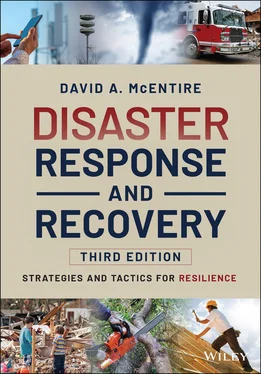David A. McEntire - Disaster Response and Recovery
Здесь есть возможность читать онлайн «David A. McEntire - Disaster Response and Recovery» — ознакомительный отрывок электронной книги совершенно бесплатно, а после прочтения отрывка купить полную версию. В некоторых случаях можно слушать аудио, скачать через торрент в формате fb2 и присутствует краткое содержание. Жанр: unrecognised, на английском языке. Описание произведения, (предисловие) а так же отзывы посетителей доступны на портале библиотеки ЛибКат.
- Название:Disaster Response and Recovery
- Автор:
- Жанр:
- Год:неизвестен
- ISBN:нет данных
- Рейтинг книги:5 / 5. Голосов: 1
-
Избранное:Добавить в избранное
- Отзывы:
-
Ваша оценка:
- 100
- 1
- 2
- 3
- 4
- 5
Disaster Response and Recovery: краткое содержание, описание и аннотация
Предлагаем к чтению аннотацию, описание, краткое содержание или предисловие (зависит от того, что написал сам автор книги «Disaster Response and Recovery»). Если вы не нашли необходимую информацию о книге — напишите в комментариях, мы постараемся отыскать её.
The new edition of the standard textbook in the field, updated with new studies and practical guidelines for reacting to the complexities of today’s disasters Disaster Response and Recovery: Strategies and Tactics for Resilience
Disaster Response and Recovery: Strategies and Tactics for Resilience, Third Edition
Disaster Response and Recovery — читать онлайн ознакомительный отрывок
Ниже представлен текст книги, разбитый по страницам. Система сохранения места последней прочитанной страницы, позволяет с удобством читать онлайн бесплатно книгу «Disaster Response and Recovery», без необходимости каждый раз заново искать на чём Вы остановились. Поставьте закладку, и сможете в любой момент перейти на страницу, на которой закончили чтение.
Интервал:
Закладка:

Figure 2‐1 Elective officials such as Freeport, NY Mayor, Andrew Hardwick, often meet with community members to discuss ongoing response and recovery efforts. Andrew Booher/FEMA.
2.1.2 County and Regional Governments
County/parish governments and regional governments are also heavily involved in pre‐ and post‐disaster operations (Clarke 2006). Counties or parishes may have their own emergency management offices, and their employees often work with their peers at the municipal level. County/parish emergency management offices are typically responsible for unincorporated areas also. They generally have supplementary resources that can be deployed when disasters prove to be too much for local governments. In this case, a county judge or commissioner (or parish president in the State of Louisiana) may also declare a disaster and work with state and federal governments to acquire disaster assistance. In fact, presidentially declared disasters (those requiring federal assistance) are always initiated at the county level before they make their way up through the state emergency management system.
Those involved in emergency management at the county‐level work perform a variety of disaster functions. The sheriff’s office may help with traffic control or other law enforcement duties after disasters. The Geographic Information Systems Department plots the location of resources when emergency management activities are undertaken. Public Health provides health services after all types of disasters, and they are key players in the distribution of medicines or vaccines to affected communities. The County Economic Development Department performs vital work during recovery. These county entities cooperate with other agencies at the municipal level and often cover unincorporated areas to ensure disaster funds are distributed and spent according to federal policy and regulations. Again, it is worth repeating, that no two county governments are exactly alike when it comes to emergency management.
Regional governments are networks of local and county governments that address collective problems across numerous counties in rural or in large metroplex locations. For instance, there is a regional government representing the eight counties in the San Joaquin Valley as well as the Sacramento Area Council of Governments that is involved with cities in that general vicinity. These organizations focus on daily concerns (e.g., transportation and environmental issues) that affect multiple jurisdictions. However, regional governments also give attention to disasters and emergency management (Kapucu 2012; Gerber and Robinson 2009); Waugh 1994) and may be the conduit by which the federal government distributes grant monies for local governments. In fact, the federal government prefers to award grants to regional governments to avoid duplication of effort and unnecessary expenses. In return, regional governments are expected to share their resources (e.g., hazardous material teams or swift water rescue boats) with local jurisdictions in need when disasters occur.
The North Central Texas Council of Governments (NCTCOG) is one example of a regional governmental organization that is interested in disasters. This particular network of jurisdictions attempts to strengthen local governments by assisting them in cooperative efforts across the Dallas/Fort Worth region. The NCTCOG has a department dedicated to regional disaster planning and coordination. The Emergency Preparedness Program provides leadership to facilitate collaboration across jurisdictions in this geographic area when disasters occur. Even though regional governments like NCTCOG have been around for decades, their importance remains underestimated in emergency management today.
2.1.3 State Government
State agencies are also heavily involved in response and recovery operations (NEMA, no date). The state governmentis the intermediary between the federal government and local and county/parish jurisdictions. It works with numerous politicians and public servants from cities, counties and regional governments to address a whole host of issues. The state includes departments similar to those at the local and county levels, with some notable differences as well. It is an important stakeholder in emergency management.
For instance, the State Emergency Management Agency is somewhat similar to the local emergency management office. It collaborates with all other departments at the state level in addition to local, county, and federal emergency management organizations. The State Emergency Management Agency may be an independent entity, or it can be affiliated with the governor’s office or even a state homeland security agency. In fact, since 9/11, emergency management and homeland security offices have undergone several organizational transformations. Sometimes, these agencies are co‐located, while in other cases they are separate entities. At times, they may be referred to as the Division of Emergency Management, the Emergency Management Agency, the Department of Homeland Security or the Homeland Security Agency. The important point to remember is that emergency management is typically more concerned with all types of disaster issues, while homeland security is generally geared toward crime and terrorist activity.
Besides emergency management and homeland security agencies, there are many other departments that become involved in disasters at the state level. As an example, the Department of Forestry is in charge of suppressing forest fires ( Figure 2‐2). It is somewhat similar to a local fire department, but it is much larger and operates in rural areas instead of cities. The Department of Forestry has large ground crews as well as air support (e.g., helicopters and tankers) to assist when wildfires occur. The Department of Public Safety or Highway Department acts much like the local police department by handling traffic control after disasters. In some states, like Texas, the state Department of Public Safety plays an important role in assessing and declaring disasters. In other cases, emergency management offices are located in the Department of Public Safety or in a Division of the Governor’s Office.

Figure 2‐2 State firefighting resources such as this helicopter will be utilized to extinguish blazes as was the case in Loveland, CO. Michael Rieger/FEMA.
In addition to these agencies, many other departments in state government participate in response and recovery operations. The Department of Transportation facilitates large‐scale evacuations and rebuilds freeways after disasters. The Health Department at the state level assists with public and mental health issues. The Housing Department addresses housing shortages made evident after disasters. The Environment Department protects the quality of natural resources such as soil and water if they are adversely affected by a hazard. The loss of crops and cattle is a priority of the state Agriculture Department. The state Department of Insurance and Department of Commerce may also become involved in disasters if there are conflicts regarding the settlement of claims or if it appears that price gouging has occurred after disasters.
For Example
Evacuation before Hurricane Rita
After witnessing several weaknesses in Louisiana’s response after Hurricane Katrina, Texas wanted to avoid going through similar problems. The Texas Division of Emergency Management and Department of Public Safety worked closely with local law enforcement officials to evacuate Houston citizens prior to the arrival Hurricane Rita. When the northbound side of the freeway became jammed with thousands of motorists, the southbound lanes were reversed. This increased traffic flow but required the coordinated assistance of many police officers, sheriffs and others from the highway patrol. The state also had to provide gas for vehicles that ran out of fuel. The state worked with north Texas communities to receive evacuees and open shelters. The evacuation was not without problems as some elderly residents died due to the stress of evacuation. However, hundreds of thousands of people were successfully moved from harm’s way.
Читать дальшеИнтервал:
Закладка:
Похожие книги на «Disaster Response and Recovery»
Представляем Вашему вниманию похожие книги на «Disaster Response and Recovery» списком для выбора. Мы отобрали схожую по названию и смыслу литературу в надежде предоставить читателям больше вариантов отыскать новые, интересные, ещё непрочитанные произведения.
Обсуждение, отзывы о книге «Disaster Response and Recovery» и просто собственные мнения читателей. Оставьте ваши комментарии, напишите, что Вы думаете о произведении, его смысле или главных героях. Укажите что конкретно понравилось, а что нет, и почему Вы так считаете.












